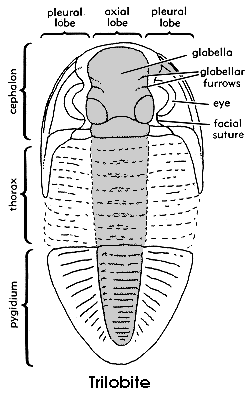TRILOBITES
("three lobes")
Trilobites
derive their name from the fact that their bodies are
divided into a central axial lobe in the middle and
two pleural lobes on the sides. The head, or cephalon,
is typically crescent-shaped and often bears two compond
eyes (although some trilobites were blind). The swelling
in the middle of the cephalon is the glabella; to the
sides are the eyes and the facial sutures, which separate
the free cheeks, or librigenae, from the rest of the
cephalon. The free cheeks on the specimen above have
been slightly detached.
The
pleural lobes are made up of overlapping pleurae, which
covered the delicate legs. Trilobite legs were biramous,
bearing both walking branches and feathery gills; food
was passed forward to the mouth by the expanded basal
segments of the legs, called gnathobases.
At
the posterior of the body, the pleurae were fused into
a flattened tail-like segment, or pygidium. In some
trilobites the pygidium is quite small; in others it
is large and ornamented with spines.
|

Illistration
from the
Kansas
Geological Survey
During
the Ordovician Geological Period, some species reached
over 30 inches in length, but by the Pennsylvanian Geological
Period most were extinct and the few left were small.
Trilobites became extinct at the end of the next
geological period, the Permian.
|
